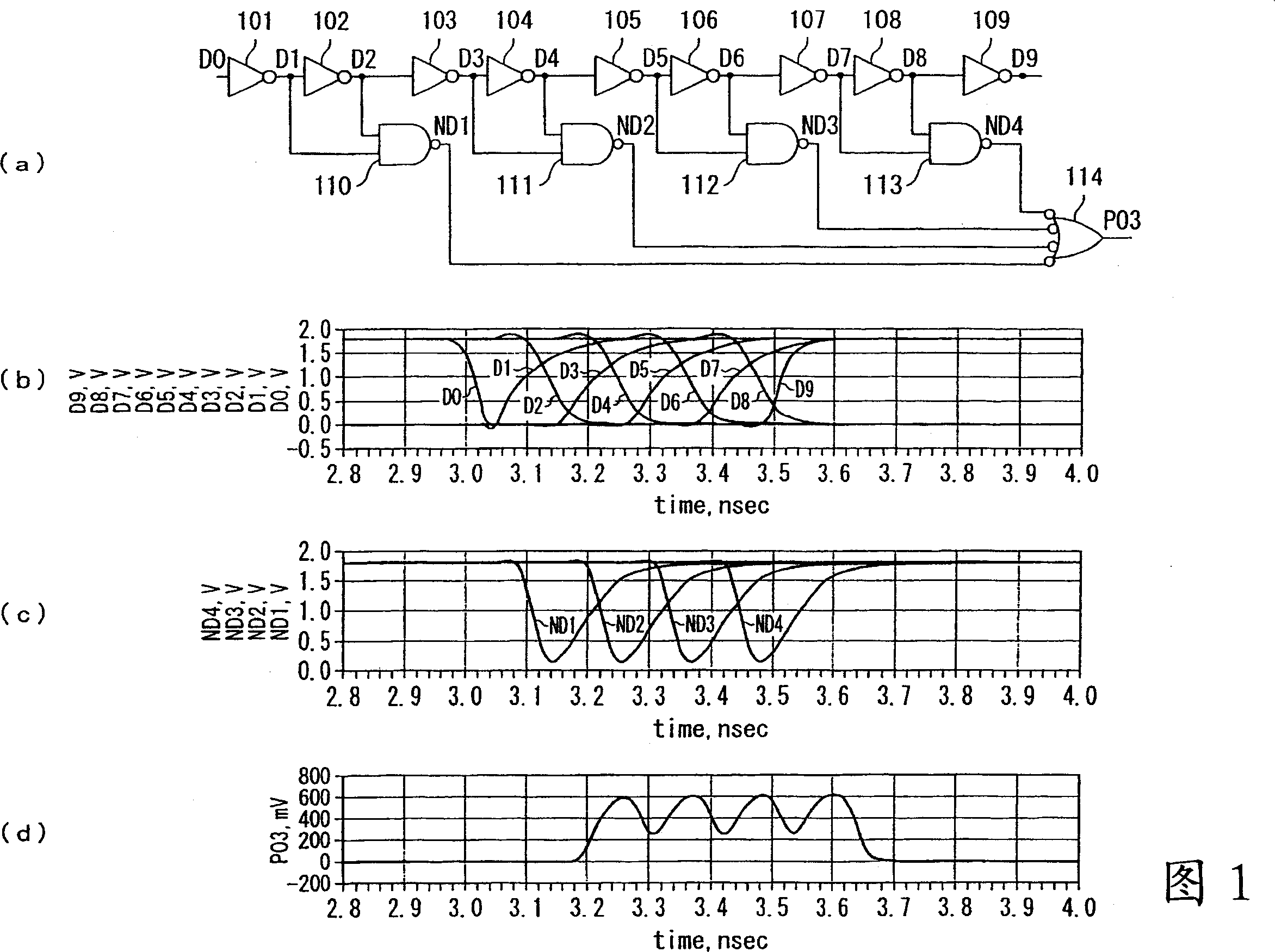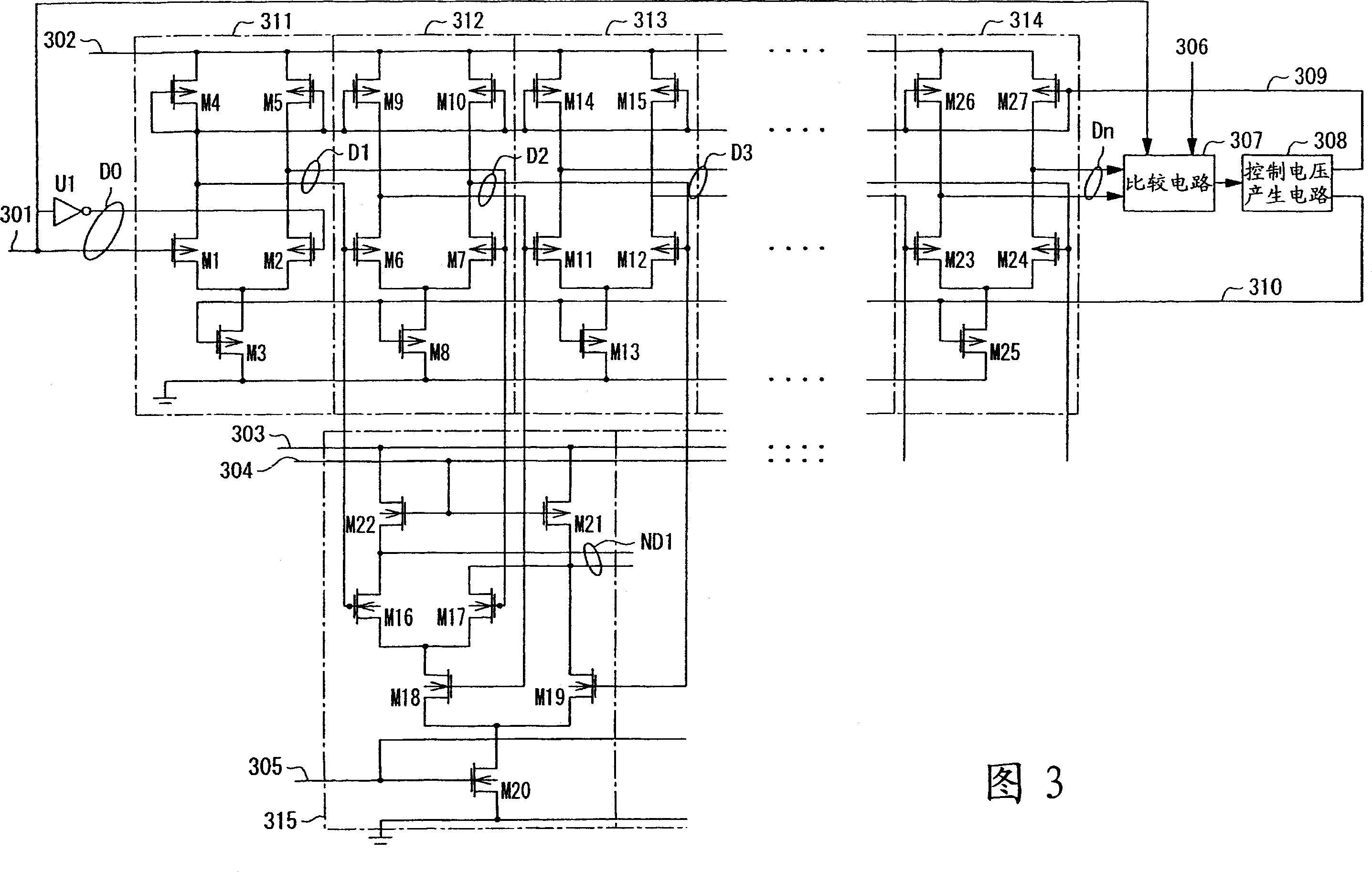Pulse generating circuit, electronic device using this pulse generating circuit, and information transmitting method using this circuit
A technology for generating circuits and buffer circuits, applied in the direction of electric pulse generator circuits and logic circuits to generate pulses, etc., can solve the problems of increased energy consumption, impossibility, and difficulty in obtaining components, and achieve the effect of easy implementation
- Summary
- Abstract
- Description
- Claims
- Application Information
AI Technical Summary
Problems solved by technology
Method used
Image
Examples
no. 1 Embodiment approach
[0084] 1( a ) is a circuit diagram showing a main part of a pulse generating circuit according to the first embodiment of the present invention, and ( b ) to ( d ) are timing charts for explaining its operation. However, as an example, using the pulse waveform shown in Fig. 6(a) and using D Included in the case of four pulses (P D =8P W ) refers to pulses whose quantity is 4 for illustration.
[0085] Reference numerals 101 to 109 shown in FIG. 1( a ) denote inverter circuits connected in cascade. Each input / output terminal is given a terminal name like D0-D9.
[0086] When the input terminal D0 changes from a high level (H) to a low level (L) as shown in (b), each output propagates with a delay of t.
[0087] When both of D1 and D2, D3 and D4, D5 and D6, and D7 and D8 are H respectively, NAND circuits 110-113 output L from terminals ND1-ND4 as shown in (c). When one of ND1 to ND4 is L, the "NOR" (NOR) circuit (NOR circuit of negative logic) 114 outputs H as shown in figu...
no. 2 Embodiment approach
[0094] FIG. 2 is a circuit diagram showing main parts of a pulse generating circuit according to a second embodiment of the present invention.
[0095] Reference numerals 202 and 203 denote inverter circuits with a controllable delay amount, and correspond to the inverter circuits 101 and 102 constituting the delay circuit in the first embodiment. The same circuits are used by arranging them in desired stages. In Figure 2, levels 3 onwards are not numbered. This inverter circuit 202 is constituted by a combination of a PMOS transistor M3 and an NMOS transistor M1.
[0096] The PMOS and NMOS transistors M4 and M2 are connected to the sources of the respective transistors M3 and M1, and by using these M4 and M2 to control the amount of current flowing into the inverter circuit using M3 and M1, the amount of delay thereof can be controlled.
[0097] The gate of the transistor M2 is connected to the control voltage terminal 211, and the gate of the transistor M4 is connected to ...
no. 3 Embodiment approach
[0109] 3 is a circuit diagram showing main parts of a pulse generating circuit according to a third embodiment of the present invention.
[0110] 311 to 314 are buffer circuits composed of current mode logic circuits. Taking the buffer circuit 311 as an example to describe its interior, the differential amplifier circuit is composed of a differential pair of NMOS transistors M1 and M2. The NMOS transistor M3 limits the circuit current according to the control voltage 310 applied to its gate, thereby controlling the amount of delay. The PMOS transistors M4 and M5 are loads on the output side, and the output amplitude is controlled according to the voltage applied to their gates. The buffer circuit 311 is input and output driven by a differential signal which is a characteristic of a current mode logic circuit.
[0111] Furthermore, the terminal 301 is a trigger terminal and corresponds to the terminal D0 of the first embodiment, and a target pulse is generated based on a puls...
PUM
 Login to View More
Login to View More Abstract
Description
Claims
Application Information
 Login to View More
Login to View More - R&D
- Intellectual Property
- Life Sciences
- Materials
- Tech Scout
- Unparalleled Data Quality
- Higher Quality Content
- 60% Fewer Hallucinations
Browse by: Latest US Patents, China's latest patents, Technical Efficacy Thesaurus, Application Domain, Technology Topic, Popular Technical Reports.
© 2025 PatSnap. All rights reserved.Legal|Privacy policy|Modern Slavery Act Transparency Statement|Sitemap|About US| Contact US: help@patsnap.com



